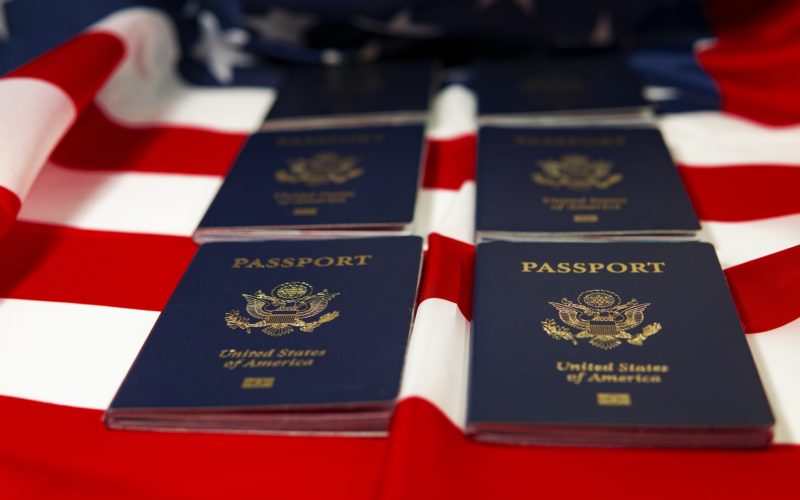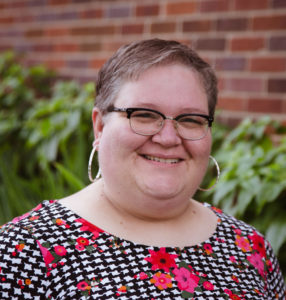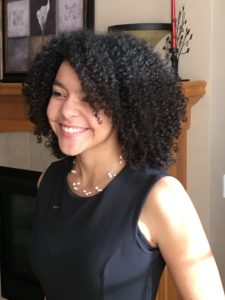Re-imagining the Citizenship Class

by Anne Dugger & Mari Hunt Wassink
Citizenship, as many of us know, is a right and a responsibility—and it requires work. Being engaged in our communities can be difficult as we navigate adult life—kids, career, school—any number of day-to-day activities can keep us away from the solemnity of advocacy, voting, and engagement. Adult learners of English face the added burden of engaging in their new lives in a new country and in a new language. At the Catherine McAuley Center (CMC) in Cedar Rapids, Iowa, we decided to reinvent what our U.S citizenship preparation classes could be. Despite spending many years teaching our students the 100 questions, the reading and writing vocabulary, and test-taking skills, we felt “citizenship” encompassed so much more!
In a typical year, our center serves about 500 adult basic education students who come from over 50 different countries. Over 450 one-on-one volunteer tutors teach English, literacy, math, computer skills, citizenship preparation, and conversation skills. Students pursuing U.S. naturalization have the option to take a 6-week citizenship course taught by staff. Originally, this course was, essentially, a course that “taught to the test.” While many students gained their U.S. citizenship through this course, we knew we could do better—our students deserved as much information and understanding as we were able to provide. In particular, we began to envision a more holistic approach—one that prepared students not only to become U.S. citizens, but also to live as informed and engaged U.S. citizens after their naturalization ceremonies.
In recent times, our national conversation has been centered on racism, xenophobia, and White supremacy on a scale we haven’t seen in many years. The majority of students at CMC are considered “people of color” in the racial caste system of the United States, and hence have been particularly targeted on a national and local scale. As staff, we started to ask students questions about their experiences in the United States as any or all of these. What we found, (and truly, what we expected) was that, in immigrating to this country, many students had walked into a historical situation they neither had a part in maintaining nor completely comprehended. Because of this, many students could not make sense of incidents in which police profiled them or neighbors commented on their accents or hijabs. These stories and anecdotes shaped our thinking as we went about reimagining just what a citizenship class could be. In particular, they highlighted how important it would be to teach students to contextualize current events within the long, complex history of the U.S., as well as to create safe spaces where students could process racist incidents on the news and in their daily lives.
Our new course, U.S. Citizenship and Civic Engagement, took two years to build. We began with a needs assessment—doing surveys, asking questions, and taking a deep dive into what was needed—and from there developed a scope and sequence for the course. Because of the breadth of material we sought to cover, we decided on a 28-week course that met once per week for 90 minutes. Although 28 weeks initially seemed prohibitively long, we found that most students spend at least this long awaiting their naturalization interviews. Hence, a longer class has allowed students to capitalize on this wait time and thoroughly explore the course material.
The course is open to students with a diversity of English proficiencies, ranging from low beginning to high advanced English proficiency. As a result, we extensively utilize differentiated instruction to effectively teach at all levels simultaneously. For example, every class reading is available in at least two difficulty levels, and volunteer teacher’s aides (when available) provide support to students during independent and small group work. Eventually, we hope to expand the course to include adult learners at the emerging literacy level, as well. Structurally, the curriculum is organized into three overarching units: history, civics/government, and community engagement. Instead of teaching all of the 100 civic questions together, followed by the reading and writing vocabulary, the test material is folded organically into each unit by topic. For example, students learn how to read and write “Congress” and “senator” as well as memorize who their U.S. senators and representatives are during the week on the Legislative Branch.
The history unit centers on teaching the essential themes, events, and people of U.S. history with an emphasis on understanding how our past influences and shapes our present. Particular attention is paid to how White colonizers’ enslavement of Africans and genocide against Native Americans form the foundation of White supremacy in our society today. Class projects and discussions are designed to engage students with primary source materials. Visual primary sources are particularly useful, because they do not require high English proficiency to understand (although depending on the source, the teacher may need to provide cultural context), and thus are perfectly suited for a classroom with a wide range of English levels. For example, students work in pairs with the 1787 diagram of the Brookes slave ship to make observations, develop hypotheses, and ask questions. Afterward, they connect their analyses as a class to the history of the Transatlantic Slave Trade and slavery in the United States. Students then discuss how and why White Americans excused the brutal institution of slavery, and how these justifications birthed today’s racist policies and ideas.
Throughout the history unit, we have found two elements crucial to fruitful class discussions: trauma-informed teaching and translanguaging. Many of the students we teach fled their home countries as refugees and asylum-seekers because of political or ethnic violence. While it would be detrimental to their success as new U.S. citizens to deny them the honest truth about our country’s history, we also do not wish to re-traumatize students through our insensitivity to students’ personal histories. Therefore, we built trauma-informed teaching techniques into the class to foster psychological safety for all the students. When studying potentially triggering topics such as genocide, we give trigger-warnings beforehand and use simple techniques, such as requesting a thumbs-up or thumbs-down, to check in with students throughout the class period. Students also establish discussion ground-rules together and review them each week. Since we set high expectations for the depth at which students will engage with each topic, we provide scaffolding to help students of many levels of literacy and English succeed. In particular, allowing students to use their first languages in pair work and individual investigation helps students to encounter the subject matter in a more familiar linguistic context before discussing their reflections or creating a project to share with the class in English (or another lingua franca).
The unit on civics and government covers the Constitution and the structure of the federal government, as well as the rights and responsibilities of U.S. citizens. We use role playing extensively to help students internalize the knowledge and skills they will need to advocate for their rights. For example, in the lesson on the First Amendment, groups of students write and perform skits demonstrating how someone could exercise each of the five rights guaranteed by the First Amendment. During the week on voting rights, students line up and pretend to check in at the polls, present an accepted ID (under Iowa law), fill out a demo ballot, and deposit it into the voting machine. Art projects and memory games are also employed to help students express and internalize course content, such as motivations for voting and names of elected officials.
Finally, the unit on community engagement exposes students to local social service agencies and centers of art and culture, and encourages them to become more active in participating and shaping community life. In our particular context, we have developed partnerships with the African American Museum of Iowa, the National Czech and Slovak Museum and Library, the Cedar Rapids Civil Rights Commission, the League of Women Voters, and Justice for Our Neighbors. We envisioned a class that would allow our students to interact with area organizations, create space for them to begin the “work” of citizenship, and to understand the history that shapes many of their encounters in their new country.
Before taking students on field trips or inviting guest speakers, we prepared the organizations to receive the students. For example, we went to both museums and first did a tour with just our staff, which includes people from multiple countries. We were looking for triggers or places where we could help our students understand the exhibits. We asked to see the docent’s scripts for tours and simplified the language or inserted trigger warnings so our students could be free to learn and soak in the history provided without fear. Before having guests present to our classes, we talked with them about interacting with immigrants and refugees, and how to best communicate with people who may need a slower pace for speaking or simplified English. We wanted to honor the learners’ capacities to understand the information presented, both by setting high expectations for how much they could understand and by coaching docents and presenters to improve the accessibility of their materials. Engaging local organizations in the curriculum has also created a reciprocal learning opportunity for these institutions. They are able to understand how to best serve a new demographic that they have not previously reached, often through misunderstanding on both sides. Through the field trips and guest presentations, students gain familiarity with the services and arts available in the community; simultaneously, participating agencies develop new strategies to engage a more diverse clientele. Taken together, we now offer an introduction to the major hubs of civic engagement in the community that connects students and institutions in a mutual learning experience.
We kept an eye on our own assumptions as we collected the information needed to begin building this class. This particular course can be a true learning experience for the teacher! As we taught the class, it became important for us to situate our own biases. The course can and will (and is designed to!) challenge us to rethink our history and to understand better the issues facing us today. Being cognizant of who teaches this course is imperative—and understanding that each person will be challenged to think about their own biases and assumptions.
Although our U.S. Citizenship and Civic Engagement curriculum is complete, we continuously update the curriculum. Our course recognizes the need to make our history relevant to our students today. With this in mind, we discuss stories that are happening in our news cycles at the moment. We also bring relevant news stories from past years to show the cyclical nature of some of this nation’s issues. For example, when we talk about the Great Depression, the teacher talks about how many people in the United States today have or had grandparents who lived through those years. We talk about the stories we’ve heard from people who lived through that time and the issues they faced for years after—food hoarding, increased insecurity, and lack of trust in banks. This can easily lead to (and has!) conversations about food insecurity today, or even generational trauma, which leads us into every day, real-world issues facing many of our nation’s population today. We always point out that these issues are continuing to happen, even today, and they impact how our students vote or for whom they advocate.
Prior to beginning our newly revised citizenship course, we had been averaging about 10 new citizens per year. The first year we began this course, we averaged 14. As the course grew into the second year, (even with a pandemic!), our new citizens numbered in the 30s last year! We found that some of our students dropped into particular classes they wanted to review or learn more about. We also found that only a few students stayed for the entire course, but often “picked back up” to fill in knowledge they needed or wanted.
We firmly believe adult English learners have something to offer their new home country and to that end, have created a class that prepares them for actively engaging in their citizenship. We encourage them to run for office, to dream big, and to really think about their choices when it comes to politics, voting, and community advocacy. Our newly re-imagined citizenship course is what our new citizens deserve as they move into unfamiliar political and social landscapes—a sense of purpose, pride in their citizenship, and the ability to steer their ship the way they see fit.
 Anne Dugger holds a master’s degree in education in teacher leadership. She is the Director of Education Services for the Catherine McAuley Center in Cedar Rapids, Iowa. Her educational interests include andragogy, educational social justice, and volunteerism as social reform. Anne is passionate about adult basic education and believes firmly that adult learners have needed skills, experience, and voices in our communities.
Anne Dugger holds a master’s degree in education in teacher leadership. She is the Director of Education Services for the Catherine McAuley Center in Cedar Rapids, Iowa. Her educational interests include andragogy, educational social justice, and volunteerism as social reform. Anne is passionate about adult basic education and believes firmly that adult learners have needed skills, experience, and voices in our communities.
 Mari Hunt Wassink served as the Education Program Coordinator at the Catherine McAuley Center from 2017 to 2020. She holds a B.A. in history and Spanish from Coe College. As an educator, she is passionate about helping people achieve their goals and become informed and engaged members of society who advocate for themselves and their communities.
Mari Hunt Wassink served as the Education Program Coordinator at the Catherine McAuley Center from 2017 to 2020. She holds a B.A. in history and Spanish from Coe College. As an educator, she is passionate about helping people achieve their goals and become informed and engaged members of society who advocate for themselves and their communities.